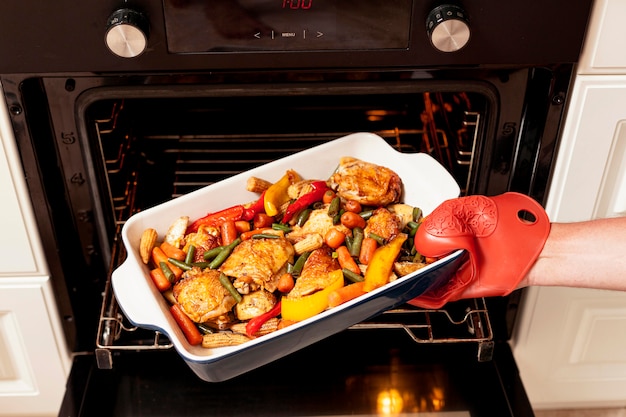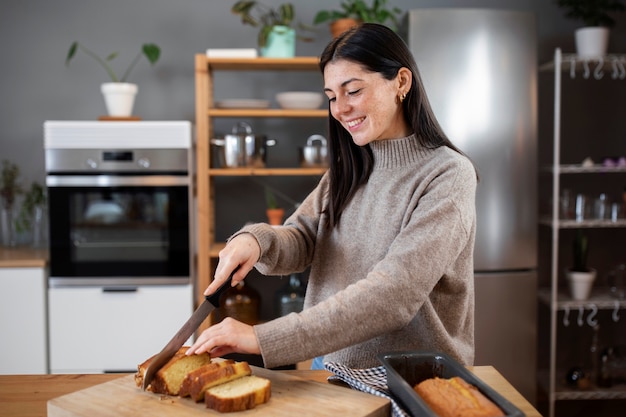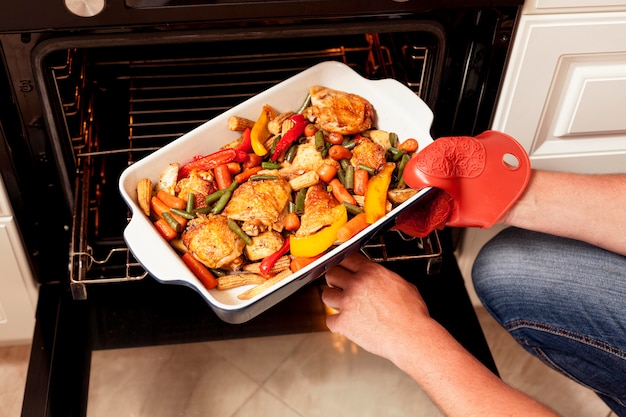(Part 1) Choosing Your Star: The Perfect Roast Cut

The first step in any epic culinary adventure is selecting your star ingredient. When it comes to roasts, the choice is yours, from the classic beef roast to the more delicate lamb or the versatile pork.
What’s Your Flavor Profile?
Before you even think about the specific cut, consider the flavour you're aiming for. Are you craving a robust, beefy flavour? Or perhaps something lighter and more delicate like chicken? Maybe you’re longing for the rich, gamey taste of duck or the savory goodness of a lamb roast seasoned with rosemary. Let your culinary desires guide you.
Beyond the Type: Picking the Perfect Cut
Now that you’ve chosen the type of meat, it’s time to choose the cut. This is where it gets a bit more technical, but don't worry, I'll keep it simple. The key is to pick a cut with a good amount of fat, which will help keep the meat juicy and flavorful during cooking.
Roast Cuts: Your Options Explored
Here’s a rundown of some of my favorite roast cuts, along with their typical cooking times. Remember, these are just general guidelines. Always use a meat thermometer to ensure your roast is cooked to your desired level of doneness.
- Beef: The king of roasts! For a truly impressive centerpiece, consider a sirloin roast, rib roast, or a rump roast. They’re all sure to wow your guests.
- Lamb: With its delicate flavour, lamb is a versatile choice. A leg of lamb is a classic, while shoulder of lamb offers a more robust flavour. And for a truly special occasion, try a rack of lamb – it’s sure to make a statement.
- Pork: A crowd-pleaser, pork is known for its delicious flavour and versatility. A pork loin is a go-to option, while a shoulder roast offers a more tender and flavorful experience. For a truly impressive presentation, consider a tenderloin roast.
- Chicken: A classic for a quick and easy roast. A whole chicken is perfect for a family dinner, while chicken breast is great for a smaller meal.
- Duck: A rich and flavorful option with a distinct flavour and tender texture. Go for a whole duck for a classic roast or duck breasts for a more elegant presentation.
(Part 2) The Symphony of Seasoning: Elevating Your Roast

You’ve got your star ingredient chosen. Now, let’s give it the star treatment – we’re talking about seasoning! Don’t underestimate the power of a good seasoning blend; it’s the key to unlocking the full potential of your roast.
Beyond Salt and Pepper: Building Flavour Profiles
While salt and pepper are essential, they’re just the beginning. Think of seasoning as adding layers of flavour, a symphony of taste that complements and elevates the meat. Herbs and spices are your orchestra, adding depth and complexity.
My Secret Weapon: Tried and True Seasoning Blends
I always have a few go-to seasoning blends in my pantry, ready to transform any roast into a culinary masterpiece. Here are a couple of my favourites:
- For Beef: Salt, pepper, smoked paprika, garlic powder, onion powder, rosemary, thyme. This blend brings a smoky, savory flavour that pairs perfectly with the richness of beef.
- For Lamb: Salt, pepper, garlic powder, oregano, rosemary, mint, lemon zest. This blend adds a fresh, herbaceous flavour that complements the delicate taste of lamb.
- For Pork: Salt, pepper, sage, rosemary, thyme, garlic powder, onion powder. This blend creates a warm, earthy flavour that brings out the sweetness of pork.
- For Chicken: Salt, pepper, paprika, garlic powder, onion powder, oregano, thyme. This blend adds a warm, savory flavour that perfectly complements the mild flavour of chicken.
- For Duck: Salt, pepper, orange zest, thyme, sage, bay leaves. This blend creates a rich, citrusy flavour that contrasts beautifully with the richness of duck.
The Art of Seasoning: A Light Hand is Key
Remember, you don’t want to overwhelm your roast. A light hand is key here. Season generously but avoid piling on the seasoning too thickly. It’s all about creating a harmonious balance. And don’t forget to season the inside of the roast as well, especially if you're stuffing it.
Achieving that Exquisitely crispy skin
One last tip: If you want a crispy skin, pat the meat dry before seasoning it. This allows the skin to brown beautifully and achieve that irresistible crunch.
(Part 3) The Prep Work: Setting the Stage for Roasting

Your roast is seasoned and ready to go. Now, let’s set the stage for the grand performance – the roasting itself.
Preheat Your Oven: Essential for Even Cooking
First things first, preheat your oven to the correct temperature. This is crucial for ensuring your roast cooks evenly and develops a beautiful crust. I always preheat my oven for at least 30 minutes before putting in the roast, giving it time to reach the desired heat.
Racking Up: The Importance of Air Circulation
Place the roast on a rack in a roasting pan. This allows air to circulate around the meat, helping it cook evenly and achieve that gorgeous golden-brown crust.
A Fat-tastic Trick: Enhancing Juiciness
Here’s a little secret for a juicy, tender roast: rub some butter or oil on the surface of the meat before you put it in the oven. It’ll create a flavorful crust and prevent the meat from drying out.
Time to Roast: The Journey Begins
Finally, it’s time to pop that roast into the oven. How long you roast it for will depend on the size and type of meat, and the temperature you've set the oven to.
(Part 4) The Temperature Tango: The Heart of Roast Perfection
We’ve reached the heart of the matter – temperature. It's not just about the oven temperature; it’s about the internal temperature of the meat. You want to make sure it's cooked through but not overcooked.
The Meat Thermometer: Your Culinary Compass
Honestly, the best way to ensure perfect temperature is to use a meat thermometer. It's a game-changer, I tell you! You can find them at most supermarkets and kitchen shops.
Internal Temperature Guide: The Doneness Dictionary
Here are the recommended internal temperatures for different types of meat, ensuring your roast reaches the perfect level of doneness.
| Meat | Internal Temperature (°C) | Description |
|---|---|---|
| Beef (rare) | 50-52 | Red center, cool to the touch |
| Beef (medium-rare) | 54-57 | Pink center, slightly warm to the touch |
| Beef (medium) | 57-60 | Pink center, warm to the touch |
| Beef (well-done) | 60 | No pink, hot to the touch |
| Lamb | 63-65 | No pink, hot to the touch |
| Pork | 63-65 | No pink, hot to the touch |
| Chicken | 74 | No pink, hot to the touch |
| Duck | 74 | No pink, hot to the touch |
(Part 5) roasting time: The Culinary Clock
Now that you’re armed with the knowledge of proper temperatures, let’s talk about roasting time. How long you cook your roast depends on the size and type of meat.
Roast Time Guide: A General Timeline
Here’s a general guide to roasting times for various cuts. Remember, these are just estimates. Always use a meat thermometer to ensure your roast is cooked to perfection.
Beef Roasts
For a 2-3 kg beef roast, cook for 2-3 hours at 160°C.
Lamb Roasts
For a 2-3 kg lamb roast, cook for 1.5-2 hours at 160°C.
pork roasts
For a 2-3 kg pork roast, cook for 1.5-2 hours at 160°C.
Chicken Roasts
For a 1.5-2 kg chicken roast, cook for 1-1.5 hours at 180°C.
Duck Roasts
For a 1.5-2 kg duck roast, cook for 1-1.5 hours at 180°C.
Remember, these are just general guidelines. Always use a meat thermometer to ensure your roast is cooked through.
(Part 6) The Resting Ritual: Unlocking Juiciness
Your roast is cooked! But don’t get ahead of yourself and dive right in. Let it rest. I know, it's hard to wait, but trust me – resting your roast is crucial for optimal results.
Why Resting is a Must: The Science of Juiciness
Resting allows the juices to redistribute throughout the meat, resulting in a more tender and juicy roast. It's a simple step with a huge impact on the final product.
Resting Time: Patience is a Virtue
A good rule of thumb is to rest the roast for at least 15 minutes before carving. Cover it loosely with foil to keep it warm and prevent it from drying out.
(Part 7) A Symphony of Sides: Completing the Culinary Ensemble
A roast is never truly complete without a delightful ensemble of side dishes. Let's explore the culinary world of roast accompaniments.
The Classics: Timeless Roast Pairings
Let’s start with the classics. roast potatoes, crispy on the outside and fluffy on the inside, are a must-have for any roast dinner. And don’t forget the gravy – the perfect way to bring everything together, enveloping your roast and sides in a delicious embrace.
Beyond Tradition: Exploring Side Dish Possibilities
But don't be afraid to venture beyond the classics. roast vegetables like carrots, parsnips, and Brussels sprouts offer a vibrant medley of colours and textures. A fresh green salad with a tangy vinaigrette provides a refreshing contrast to the richness of the roast. And let’s not forget yorkshire puddings – a real crowd-pleaser, light and fluffy with a crispy exterior.
(Part 8) The Leftover Magic: Transforming Remnants into New Delights
Let’s face it, you’re probably going to have some leftover roast. But don’t despair! Leftover roast is a culinary treasure trove, waiting to be transformed into new and delicious dishes.
Leftover Classics: Turning Leftovers into New Stars
A simple roast sandwich is always a winner. Or, elevate your leftovers into a hearty shepherd's pie, layering leftover roast with mashed potatoes and gravy.
Beyond the Familiar: Unleashing Creative Leftover Potential
But why stop there? Get creative! You could use leftover roast in a salad, a stir-fry, or even a soup. Let your imagination run wild and discover endless possibilities for repurposing leftover roast.
(Part 9) FAQs: Answering Your Roast-Related Queries
I know you’ve got questions. That's why I've put together a list of frequently asked questions to help you on your roasting journey.
1. How Do I Know If My Roast is Cooked?
The best way to tell if your roast is cooked is to use a meat thermometer. Check the internal temperature to ensure it’s reached the recommended level.
2. What if My Roast Is Overcooked?
Don’t panic. It’s not the end of the world. An overcooked roast will be a little dry, but it can still be tasty. Just make sure to carve it thinly and serve it with plenty of gravy.
3. What If My Roast Is Undercooked?
This is a little trickier. If your roast is undercooked, you’ll need to cook it for a little longer. But make sure to check the internal temperature regularly to avoid overcooking it.
4. Can I Roast Frozen Meat?
I wouldn’t recommend it. Frozen meat takes longer to cook, and it can be difficult to get it cooked evenly. It’s always best to defrost meat completely before roasting.
5. What if My Roast Doesn’t Brown Properly?
There are a few things you can try. Make sure the oven is hot enough. Try raising the rack to get the roast closer to the heat source. Or, you could brush the roast with a little bit of oil or butter halfway through cooking.
I hope you've found this guide helpful and inspiring. Now go forth and create culinary magic with your roasts. Happy cooking!
Everyone is watching

Corn on the Cob: The Ultimate Guide to Perfectly Cooked Ears
Healthy MealsAh, corn on the cob. Just the name evokes images of sunny days, barbecues, and that sweet, juicy flavour that ...

Perfect Pork Roast Oven Cooking Time: A Guide to Delicious Results
Healthy MealsThere's something truly satisfying about a perfectly roasted pork. The aroma alone is enough to make your mout...

Ham Cooking Time: How Long to Bake, Smoke, or Boil a Delicious Ham
Healthy MealsAh, ham. It's a classic, isn't it? A real crowd-pleaser, especially around holidays. And when done right, it'...

Scallops: The Ultimate Guide to Perfect Cooking
Healthy MealsAh, scallops. Those delicate, sweet, and utterly delicious morsels of the sea. They hold a special place in my...

Spaghetti Squash: The Ultimate Guide to Cooking and Serving
Healthy MealsRemember that time you saw spaghetti squash at the supermarket, looking all bumpy and strange, and thought, "W...
